Is your computer not “recognizing the external drive?” Does the “USB connected to your PC not show up?” Is the “Flash drive not detected by the PC?”
50% OFF

BLACK FRIDAY OFFERS
Unlock Black Friday Mega Savings — Systweak Tools FLAT 50% OFF!
If you are struggling with any of these issues, here is a list of workable ways to fix these issues.
USB is a popular technology that allows connecting various devices to the PC. Setting it up is quite easy. However, when the USB is plugged in but does not show up, the actual struggle starts. This can happen due to several reasons such as damaged USB, outdated drivers, incorrect file system, device conflict, faulty hardware, or issues with partitions.
Pinpointing the exact reason is not easy. However, by following the fixes below, you can fix the issue of the thumb drive not showing up.
What is a USB Device?
It is a peripheral device that plugs into a PC via a Universal Serial Bus port. A thumb drive, external hard disk, and pen drive are comm USB devices and are less expensive compared to hard disk drives. Also, their processing speed is faster.
What Does USB Disappearing Mean?
The connected USB stick is not appearing in File Explorer or the Disk Management section.
Reasons For External Drive Not Showing
- The USB drive is not properly connected to the PC.
- The USB drive is broken.
- Unable to properly load USB software onto the system.
- The drive may be infected by malware.
- A low system battery might make Root hub settings unrecognize the drive.
- Windows is out of date.
- Hardware compatibility.
- No partition & drive letter is assigned to the USB drive.
Read Also- How to Download And Update Lenovo USB Drivers
How To Fix USB Drive Not Showing Up?
The issue of the USB stick not showing up or the computer not recognizing the external hard drive can be fixed differently. However, before we get into the technical details, let us perform some basic troubleshooting.
Method 1 – Perform Basic USB Checks
Step 1 – Restart PC – Most errors you face on Windows result from system malfunctioning. Therefore, to fix the problem, the first step should be to restart the computer.
Step 2 – Update Windows – If restarting the PC doesn’t help, update your Windows. This will install the patches that will fix any known issues and bugs. To do so, follow these steps:
- Press Windows + I to open Windows settings.

- Click Update & Security.

- Windows Update > click Check for update.

- The system will now check for available updates. If any are available, they will be automatically downloaded.
- Download and install them to run the latest version.
- Restart your computer to save changes.
Step 3 – Connect USB to Other Port – Corrupt or dead USB port can be why the USB device is not recognized. To check it, try connecting the USB to an alternate port and see if it helps.
Step 4 – Check if the power button is on – Some USB drives have an external power button, which, if disabled, leads to the pen drive not showing. To fix it, check if your drive has one and enable it.
Step 5 – Check the USB drive for physical damage – If the USB device you are connecting has a crack or a bed, it could be a reason for the USB stick not showing up. In this case, contact a technician.
Step 6 – Check for USB device compatibility – Sometimes, the USB does not show up because it isn’t compatible with the PC. Using a USB 3 on a USB 2 port is common. However, some USB 3 devices need a compatible and powerful port. If you face issues with the computer not recognizing the external hard drive, you should check the device manual and compatibility information.
If these basic fixes didn’t help with PC not recognizing the external hard drive, follow the other fixes explained below.
Check This- How to Download Apple Mobile Device USB Driver for Windows 11,10,8,7
Method 2 – Assign Drive Letter
If the connected USB stick is visible in Disk Management but not in File Explorer, it means the drive is readable, but due to outdated drives, drive letter conflict, and file system errors, you are facing this error. Below we explain the method to resolve the USB stick not showing.
- In the Windows search bar, type My PC.
- Select best search results > select Manage.

- Right-click the USB drive under Disk Management > and select Change Drive Letter and Paths.

- Next, click Add.

- By default, the available drive letter will be selected. Click Ok to assign it. However, if you want to assign a drive letter of your choice, choose it from the drop-down menu > and click Ok.

Method 3 – Change USB Root Hub Settings
To save power, sometimes, the system disables the connected USB. To confirm this is not the case, check and alter USB Root Hub settings.
- Press Windows + X > select Device Manager.
- Go to Universal Serial Bus controllers.

- Double-click to expand it > right-click USB Root Hub (USB 3.0) > select Properties.

- Click the Power Management tab > and uncheck the box next to Allow the computer to turn off this device to save power. Click Ok.

- Now try to connect the USB and see if it is readable.
Method 4 – Update USB Driver
Outdated, missing, and problematic USB drivers also cause the flash drive not to show up. To fix it, update the USB drivers.
Device drivers can be updated manually through the Device Manager built-in Windows utility, manufacturer website, or via optional updates (Windows Update). Alternatively, you use Advanced Drive Updater to update drivers automatically.
Manually updating drivers requires technical knowledge, time, and patience. Therefore, if you want a simple and effective way, use Advanced Driver Updater. Below we explain how to use the best driver updater and update outdated drivers.
- Download and install Advanced Driver Updater.
- To start the scan and detect outdated drivers click Start Scan Now.

- The scanning will take a minute or so to complete. Wait for it to finish; you can update outdated drives after that.

- Analyze scan results and update drivers. The trial users must click Update Driver next to it, while the Paid users can use the Update All button.

- Wait for the driver update to install.
- Restart the PC to apply changes.
See This- How To Download and Update Qualcomm USB Driver for Windows 10
Method 5 – Scan for Hardware Changes
After updating the drivers, whether manually or automatically, we suggest you scan for hardware changes. To do so, follow these steps:
- Press Windows + X and select Device Manager.

- Click the Action tab > Scan for hardware changes.

- Windows will now look for a USB stick and hope you can see it.
Method 6 – Reinstall USB Controllers
If the USB drive is corrupt or unstable this method will help fix it.
- Press Windows + X > select Device Manager.

- Double-click on the Universal Serial Bus controllers category and expand it.

- Look for the connected USB device > select it > click Uninstall device.

Now restart your PC. The controller driver will be automatically reinstalled, and you can see the USB drive.
Method 6 – Disable USB Selective Suspended Settings
The selective suspend settings in the power options automatically disconnect the USB and make it unrecognizable. To disable it, follow these steps:
- Press Windows + X > select Power Options.

- Click Additional power settings.

- This will open a new window. Here, click the Change plan settings option.

- Click Change advanced power settings in the next window.

- In the Power settings window, locate USB settings. Double-click on it to expand options.

- You will now see the USB selective suspend setting. Click on it; you will see two settings On battery and Plugged in. Disable the settings for both options.

- Click Apply > Ok to save changes.
Fix – PC No Recognizing USB Device
The above fixes will help troubleshoot USB not showing. However, if the steps didn’t, you must either replace the USB stick or format it.
Before buying a new one, if you want to format and give it a try, follow these steps:
Double-click This PC > right-click the connected USB > select Format. Click the Start button to begin the process.

This should help fix the USB drive not recognizable issue. Please let us know which method helped in fixing the problem.
Recommended-
How To Update USB Drivers On Windows 11 & 10?
How to Download USB PnP Sound Device DriversSound Device Driver
How to Download USB Mass Storage Device Driver on Windows 11
How to Install USB 3.0 Drivers on Windows 10





